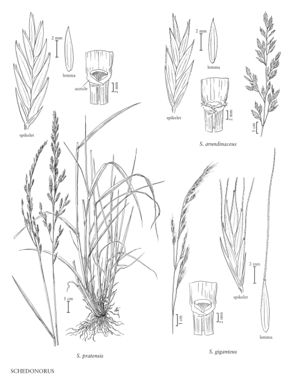Difference between revisions of "Schedonorus pratensis"
FNA>Volume Importer |
FNA>Volume Importer |
||
| Line 7: | Line 7: | ||
|synonyms={{Treatment/ID/Synonym | |synonyms={{Treatment/ID/Synonym | ||
|name=Lolium pratense | |name=Lolium pratense | ||
| − | |authority= | + | |authority= |
| + | |rank=species | ||
}} {{Treatment/ID/Synonym | }} {{Treatment/ID/Synonym | ||
|name=Festuca pratensis | |name=Festuca pratensis | ||
| − | |authority= | + | |authority= |
| + | |rank=species | ||
}} {{Treatment/ID/Synonym | }} {{Treatment/ID/Synonym | ||
|name=Festuca elatior var. pratensis | |name=Festuca elatior var. pratensis | ||
| − | |authority= | + | |authority= |
| + | |rank=variety | ||
}} | }} | ||
|hierarchy=Poaceae;Poaceae subfam. Pooideae;Poaceae tribe Poeae;Schedonorus;Schedonorus pratensis | |hierarchy=Poaceae;Poaceae subfam. Pooideae;Poaceae tribe Poeae;Schedonorus;Schedonorus pratensis | ||
| Line 26: | Line 29: | ||
-->{{Treatment/Body | -->{{Treatment/Body | ||
|distribution=Conn.;N.J.;N.Y.;Wash.;Ark.;Kans.;N.Dak.;Nebr.;Okla.;S.Dak.;Del.;D.C;Wis.;W.Va.;Mass.;Maine;N.H.;R.I.;Vt.;Fla.;Wyo.;N.Mex.;Tex.;La.;Tenn.;N.C.;S.C.;Pa.;Calif.;Nev.;Va.;Colo.;Alaska;Ala.;Mont.;Oreg.;Ill.;Ga.;Ind.;Iowa;Ariz.;Idaho;Md.;Ohio;Alta.;B.C.;Greenland;Man.;N.B.;Nfld. And Labr.;N.S.;Ont.;P.E.I.;Que.;Sask.;Yukon;Mo.;Minn.;Mich.;Miss.;Utah;Ky. | |distribution=Conn.;N.J.;N.Y.;Wash.;Ark.;Kans.;N.Dak.;Nebr.;Okla.;S.Dak.;Del.;D.C;Wis.;W.Va.;Mass.;Maine;N.H.;R.I.;Vt.;Fla.;Wyo.;N.Mex.;Tex.;La.;Tenn.;N.C.;S.C.;Pa.;Calif.;Nev.;Va.;Colo.;Alaska;Ala.;Mont.;Oreg.;Ill.;Ga.;Ind.;Iowa;Ariz.;Idaho;Md.;Ohio;Alta.;B.C.;Greenland;Man.;N.B.;Nfld. And Labr.;N.S.;Ont.;P.E.I.;Que.;Sask.;Yukon;Mo.;Minn.;Mich.;Miss.;Utah;Ky. | ||
| − | |discussion=<p>Schedonorus pratensis is a Eurasian species that is now widely established in the Flora region. It used to be a popular forage grass in the contiguous United States and southern Canada, but is now rarely planted.</p> | + | |discussion=<p><i>Schedonorus pratensis</i> is a Eurasian species that is now widely established in the Flora region. It used to be a popular forage grass in the contiguous United States and southern Canada, but is now rarely planted.</p> |
|tables= | |tables= | ||
|references= | |references= | ||
| Line 35: | Line 38: | ||
-->{{#Taxon: | -->{{#Taxon: | ||
name=Schedonorus pratensis | name=Schedonorus pratensis | ||
| − | |||
|authority=(Huds.) P. Beauv. | |authority=(Huds.) P. Beauv. | ||
|rank=species | |rank=species | ||
| Line 43: | Line 45: | ||
|family=Poaceae | |family=Poaceae | ||
|illustrator=Annaliese Miller | |illustrator=Annaliese Miller | ||
| + | |illustration copyright=Utah State University | ||
|distribution=Conn.;N.J.;N.Y.;Wash.;Ark.;Kans.;N.Dak.;Nebr.;Okla.;S.Dak.;Del.;D.C;Wis.;W.Va.;Mass.;Maine;N.H.;R.I.;Vt.;Fla.;Wyo.;N.Mex.;Tex.;La.;Tenn.;N.C.;S.C.;Pa.;Calif.;Nev.;Va.;Colo.;Alaska;Ala.;Mont.;Oreg.;Ill.;Ga.;Ind.;Iowa;Ariz.;Idaho;Md.;Ohio;Alta.;B.C.;Greenland;Man.;N.B.;Nfld. And Labr.;N.S.;Ont.;P.E.I.;Que.;Sask.;Yukon;Mo.;Minn.;Mich.;Miss.;Utah;Ky. | |distribution=Conn.;N.J.;N.Y.;Wash.;Ark.;Kans.;N.Dak.;Nebr.;Okla.;S.Dak.;Del.;D.C;Wis.;W.Va.;Mass.;Maine;N.H.;R.I.;Vt.;Fla.;Wyo.;N.Mex.;Tex.;La.;Tenn.;N.C.;S.C.;Pa.;Calif.;Nev.;Va.;Colo.;Alaska;Ala.;Mont.;Oreg.;Ill.;Ga.;Ind.;Iowa;Ariz.;Idaho;Md.;Ohio;Alta.;B.C.;Greenland;Man.;N.B.;Nfld. And Labr.;N.S.;Ont.;P.E.I.;Que.;Sask.;Yukon;Mo.;Minn.;Mich.;Miss.;Utah;Ky. | ||
|reference=None | |reference=None | ||
| Line 48: | Line 51: | ||
|publication year= | |publication year= | ||
|special status= | |special status= | ||
| − | |source xml=https:// | + | |source xml=https://jpend@bitbucket.org/aafc-mbb/fna-data-curation.git/src/f50eec43f223ca0e34566be0b046453a0960e173/coarse_grained_fna_xml/V24/V24_634.xml |
|subfamily=Poaceae subfam. Pooideae | |subfamily=Poaceae subfam. Pooideae | ||
|tribe=Poaceae tribe Poeae | |tribe=Poaceae tribe Poeae | ||
Revision as of 20:23, 16 December 2019
Plants perennial. Culms to 1.3 m. Leaves folded or convolute in young shoots; auricles glabrous; ligules to 0.5 mm; blades 10-25 cm long, 2-7 mm wide. Panicles (6)10-25 cm; branches at the lowest node 1 or 2, shorter branch with 1-2(3) spikelets, longer branch with 2-6(9) spikelets. Spikelets (8.5) 12-15.5(17) mm long, 2-5 mm wide, with (2)4-10(12) florets. Lower glumes (2)2.6-4.5 mm; upper glumes 3-5 mm; lemmas 5-8 mm, usually smooth, sometimes slightly scabrous distally, apices unawned, sometimes mucronate, mucros to 0.2 mm; paleas slightly shorter than the lemmas; anthers (1.5)2-4.6 mm. Caryopses 3-4 mm long, 1-1.5 mm wide. 2n = 14.
Distribution
Conn., N.J., N.Y., Wash., Ark., Kans., N.Dak., Nebr., Okla., S.Dak., Del., D.C, Wis., W.Va., Mass., Maine, N.H., R.I., Vt., Fla., Wyo., N.Mex., Tex., La., Tenn., N.C., S.C., Pa., Calif., Nev., Va., Colo., Alaska, Ala., Mont., Oreg., Ill., Ga., Ind., Iowa, Ariz., Idaho, Md., Ohio, Alta., B.C., Greenland, Man., N.B., Nfld. And Labr., N.S., Ont., P.E.I., Que., Sask., Yukon, Mo., Minn., Mich., Miss., Utah, Ky.
Discussion
Schedonorus pratensis is a Eurasian species that is now widely established in the Flora region. It used to be a popular forage grass in the contiguous United States and southern Canada, but is now rarely planted.
Selected References
None.
